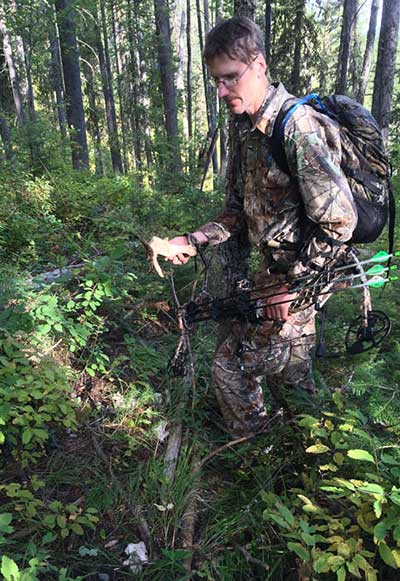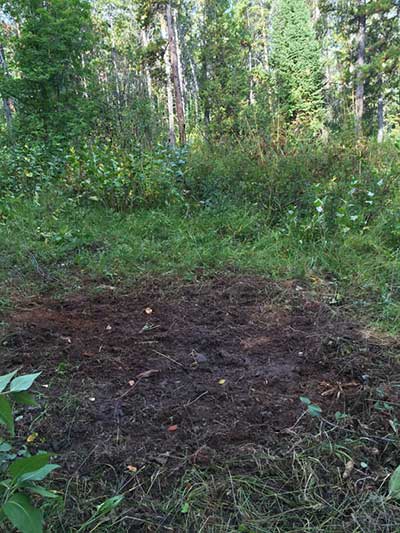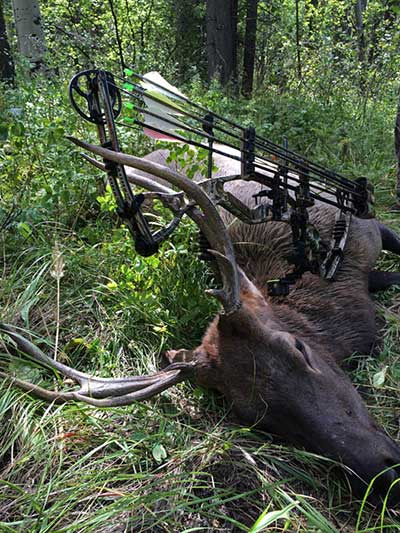LAST UPDATED: May 1st, 2015
SODA SPRINGS, Idaho – He wasn’t the biggest bull elk on the mountain, nor the wisest or baddest of his species.
But he became mine to take home when our paths crossed on an Idaho mountaintop in early September. His venison will be enjoyed and appreciated by friends and family members during the year ahead.
By my estimation, this bull and its four-by-four antlers was 2.5 years old. And judging by the fat on its hips and brisket, it was also well-fed and in good health. I have no idea how to accurately field-judge elk body weights, but hauling his meat, hide and antlers two miles back to camp required all the help I could wrangle from my three friends in camp this year: Mark Endris of Hillsdale, Wisconsin; Craig Stephani, Black Creek, Wisconsin; and Chris White, Toledo, Ohio.
Elk were wallowing last week in this muddy patch of pawed dirt atop a mountain in the Targhee-Caribou National Forest in southeastern Idaho.
Endris and I arrived in Idaho at dawn Sept. 2 after a 23-hour drive. We spent most of the day hauling gear by boat and then by foot to our campsite beside a creek flowing into the Snake River. Once our boats were empty and the campsite piled high with gear, we set up our tents, filtered water from the stream, and rigged a privy, clotheslines, cooking table and portable solar panels. Yes, solar panels. Thanks to the Internet, some of us have work obligations, even in elk camp.
My hunt began the evening of Sept. 3 after a nine-hour workday on the cell-phone and computer. A 45-minute climb on the ridge north of camp put me into an aspen flat with well-worn elk trails. I still-hunted for a half-mile before stopping to watch a muddy oval where elk had been wallowing.
I started heading back down when sunlight ceased glowing on the mountains across the way in Wyoming. I was in no hurry, though. Elk often browse through this area at dusk, so I walked slowly, stopped often and tried to imagine elk behind every aspen and Douglas fir.
My imagination let me down, however. About 100 yards into my slow exit, I caught movement to my right. Too late. A bull elk spun and bashed its way uphill, its antlers clanking off saplings and branches as it fled.
I spent all day on the mountain Sept. 4-6. Each day I thought I might get a shot when sneaking in on bugling bulls, but I never saw any of the three. They disappeared without a bark or frightened dash to safety. They were bugling one minute and silent the next. How an animal weighing 600 to 800 pounds can sneak away in total silence is one of nature’s great mysteries.
White and Stephani arrived the afternoon of Sept. 6 after flying into Salt Lake City, renting a car, and driving about four hours to a parking lot where Endris retrieved them by boat. They squeezed in a quick hunt after unloading their gear in camp, and flagged me down at dusk as I hiked back down the mountain.
White and I awoke the next day at 3:30 a.m. “It’s a fine day to hunt the elk!” I announced to Stephani, my tent-mate. He was hunting the nearby valley behind camp, so he snoozed while White and I ate breakfast, packed our gear for the day, and started the 90-minute climb to our favorite area 1,500 feet above and two miles from camp.

Two bulls challenged us about halfway there, bugling and stomping around in the dark each time our boots crunched rock or broke sticks. Finally, they realized we were potential threats, and so their bugles changed to alarm barks before they hustled away into the blackness.
We reached our destination soon after first light, but were disappointed by the silence. Unlike most hikes to “The Saddle,” this one produced no bugling bulls from the treeless two-acre mountaintop meadow. Still, we waited and listened.
As usual, White heard the day’s first bugles. Unlike my hearing – long ago degraded by gunfire, metal grinders and high-capacity bottling machinery – White’s hearing detects sounds I take on his word alone.
“There’s two bulls bugling down there,” White said, pointing northeast down the ridge toward another creek valley. “Let’s go.”
This is our third year hunting together and it was my turn to be the shooter and White the caller. The bulls’ bugling grew louder as we drew within 100 yards, but we couldn’t see them in the thick mass of young fir and mountain laurel. As I crept closer, White hung back to call. My job was to keep between him and the bulls, and hope one would get curious enough about the “lost cow” to investigate. I’d then intercept it with an arrow.
It’s a standard plan for elk, but it fails more often than succeeds; at l east for us. As I got within 75 yards of the bulls, I heard cows and calves start mewing back and forth in the forest ahead. Maybe the cows were onto us, or maybe they had other places to be. Either way, once the herd gathered its members, all I could do was mark their departure by the sound of fading bugles.
White and I discussed our next move, and decided to still-hunt toward an aspen knoll where we had sneaked into a bedded herd a year ago. The clock read 10:20 a.m. when we decided to rest, drink and snack before finishing our sneak into the aspens. As we checked emails on our smart-phones, a stick snapped from over the ridgeline beside us. When several more sticks and branches broke in the following minutes, we sneaked toward the sounds.
The noise ceased about the same time our sneak began. Still, we moved ahead, me in front, taking two to three quiet steps every 20 to 30 seconds. The bull appeared about 70 yards into our stalk, walking our way. I drew my bow when it passed behind a patch of young aspen.
I didn’t have a clear shot when it emerged from the brush, but 10 yards later it stopped and stared at White. I steadied my aim and released the arrow.
The bull’s death-run ended 80 yards later in a loud stumble and crash beneath our intended aspen knoll.
Patrick Durkin arrowed this 4-by-4 bull elk while bowhunting Sept. 7 in southeastern Idaho.
White checked his watch. “10:55 a.m., he said. “It pays to hunt all day, doesn’t it?”
Not always, but this had indeed been a fine day to hunt the elk.

 By
By 





